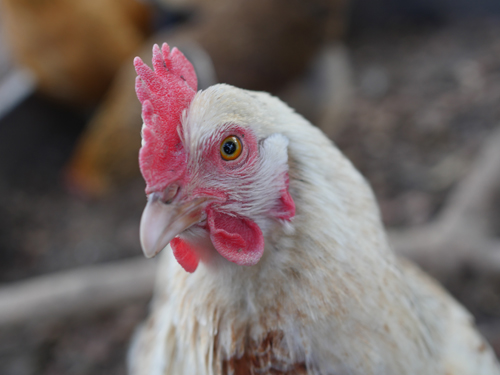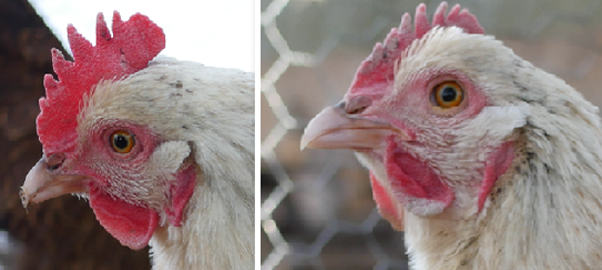About two years ago, I noticed a strange change in one of my hen’s comb and waddle, the red-colored skin above and below a chicken’s beak.
Owl, a “backyard blend” (= chicken mutt breed) is an egg laying chicken in my urban backyard flock. I got her as a 3-day-old chick, and she was the first chicken to ever lay an egg for me, so she holds a special little place in my heart. <3
Below is a photo of Owl when she started laying eggs at about 4 months old. Pay special attention to the color and size of her big, beautiful red comb and waddle.
After fall turned to winter and snow began to fall, shortly after preparing the chicken coop for winter’s cold, I noticed a physical change happening in her. She started losing patches of feathers and stopped laying eggs – obvious signs that she was going through her first molt (completely healthy & normal).
But in addition to the regular signs of molting (losing/replacing sections of feathers and ceasing egg production), Owl’s once-stunning, full, bright red comb and waddle started shrinking and turning light pink and ashy. Such an extreme change in a chicken’s comb is not normal.
As a concerned chicken mother, I started doing research and discovered that when a chicken’s comb dramatically changes colors, medically, it can mean a lot of different things – and none of them are good.
I checked her for lice and mites. She was clean. I watched to make sure she was eating and drinking. She had a healthy appetite and since she’s at the top of the pecking order, she always got to eat her fill first.
After ruling out just about every possibility I could without assistance, I finally collected a fecal sample and took it to my avian vet for testing. The vet said she was parasite free, and it was actually one of the healthiest-looking chicken poops she’s ever seen. Go figure.
Promptly after her molt, once she started laying eggs again, her plump, large comb and waddle returned to normal size and color.
So how and why did this beautiful, healthy-looking chicken’s comb and waddle shrink down into a tiny, grey, light pink blob when it used to be so bright, blood-red and big?
Honestly, the vet was stumped, and so I am.
But this is now the second time I’ve witnessed her undergo this strange comb change specifically during her molting, so I have to believe it’s just normal molting behavior for her body, even though the change is certainly extreme and noticeable.
Now let me be clear – if your chicken is going through a similar potentially medically serious circumstance, please don’t read this blog post as medical advice that everything is fine. I just wanted to share an interesting – but strange – situation in case anyone else has experienced this with a chicken.
Owl, the lovely egg-laying hen, is now back to her normal self. She’s laying eggs just fine, still eating/drinking like a champ, and her big, red, fleshy comb and waddle have returned just like they looked before her molt.
In this case of the mysterious shrinking comb, it was just her body’s unique way of molting.




